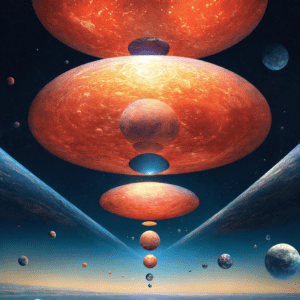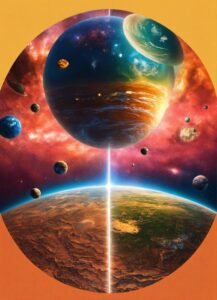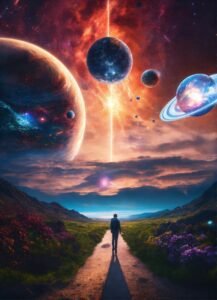Exploring Hinduism’s Lokas: String Theory Connection

String Theory, a fundamental concept in Hinduism, encompasses various dimensions and realms known as Lokas. These Lokas are not only essential in Hindu mythology but also hold significance in the realm of theoretical physics. Exploring the 14 Lokas within the framework of String Theory provides insights into the intricate connections between spirituality and science. In the vast expanse of Hindu cosmology, the 14 Lokas shimmer like celestial jewels. Join us on a voyage beyond time and space as we unravel their secrets.
Hinduism, a religion steeped in rich philosophical and cosmological traditions, offers a unique perspective through the concept of the 14 lokas. Often translated as “realms” or “worlds,” these lokas represent not just physical locations but also states of being and consciousness.
Understanding Lokas in Hinduism
What are Lokas?
Lokas, in Hinduism, refer to different planes of existence or realms. They represent various levels of consciousness and spiritual evolution. These Lokas are interconnected and inhabited by different beings, each with its own characteristics and purposes.
Significance of Lokas in Hindu Mythology
In Hindu mythology, Lokas are depicted as celestial worlds, each governed by specific deities and principles. They symbolize the cosmic order and the interconnectedness of all existence. Understanding Lokas is crucial for comprehending the complex cosmology of Hinduism.

Understanding String Theory

While not directly equivalent to the 14 lokas, a fascinating parallel can be drawn with string theory, a theoretical framework in modern physics. String theory proposes that the fundamental building blocks of the universe are not point-like particles, but rather tiny, vibrating strings existing in multiple dimensions. This concept of multiple dimensions, though hypothetical in the realm of physics, resonates with the idea of various lokas within Hinduism, suggesting a deeper understanding of the universe beyond our everyday perception.
The 14 Lokas in String Theory: A Celestial Symphony
In Hindu cosmology, the concept of “Lokas” holds a significant place. These Lokas represent various planes of existence that comprise the vast and intricate structure of the universe. Each Loka has its own distinctive attributes, inhabitants, and purpose. Let’s explore this celestial symphony:
The 14 lokas can be broadly categorized into three regions:
- Upper Lokas (Bhuloka to Satyaloka):These seven realms represent the physical and spiritual planes accessible to embodied beings.
- Middle Lokas (Maharloka to Brahmaloka):These four realms are associated with higher planes of existence and subtle dimensions.
- Lower Lokas (Atala to Patala):These three realms represent the subterranean world, often associated with darkness and negative energies.

14 Lokas
Satyaloka (Brahma Loka):
Satyaloka is the highest Loka (Realm), where Sri Chatur Mukha Brahma resides, the creator of the universe. Souls released from the cycle of rebirth find liberation here. It represents the realm of ultimate truth and spiritual realization.
Tapoloka:
Tapoloka is the abode of ascetics and great sages who seek spiritual enlightenment through austerity and meditation. A realm of deep meditation and profound wisdom.
Janaloka:
Janaloka is where great saints and enlightened beings reside, devoted to the pursuit of knowledge and wisdom. Intellectual and spiritually enlightened beings reside here.
Maharloka:
Maharloka is inhabited by celestial beings and sages who assist in the governance of the universe. It is a realm of spiritual contemplation. Ascetics and seekers of inner truth find solace here.
Svargaloka (Indra Loka):
Svargaloka is the heavenly abode of the gods (celestial beings), including deities like Indra and Agni, who preside over various aspects of the cosmos. It is often associated with pleasure and prosperity. It is a realm of pure light, divine energy, and celestial entities.
Bhuvarloka:
Bhuvarloka is An intermediary region between earthly and celestial planes, where humans and mortal beings reside, experiencing the cycle of birth and death. Celestial beings and subtle energies dwell here.
Bhuloka (Earthly Realm):
Bhuloka is the physical plane of existence, encompassing the material world and the five elements. It is our familiar world, where human experiences unfold. It is the plane of actions, karma, and spiritual growth.
Atala:
Atala is one of the lower Lokas, characterized by opulence and luxury, but also by materialism and indulgence. It is associated with desire and sensuality. Inhabitants are driven by materialistic and selfish desires.
Vitala:
Vitala is the Loka inhabited by demons and malevolent beings with dominant natures, representing the darker aspects of existence. It is characterized by power and control.
Sutala:
Sutala is ruled by the demon king Bali, known for his devotion and generosity, despite his demonic lineage. Opulence and beauty coexist here.
Talatala:
Talatala is a realm of wealth and prosperity, associated with arrogance and egotism, the serpent deity Vasuki. Beings with a strong sense of self-importance inhabit it.
Mahatala:
Mahatala is a deeper layer of existence, the abode of Nagas, serpent beings who guard the treasures of the earth. It is obscured by darkness and mystery.
Rasatala:
Rasatala is a Loka marked by chaos and conflict, filled with serpents and demons, representing the primal forces of creation and destruction. A realm where inner struggles manifest.
Patala:
Patala is the lowest Loka, shrouded in secrecy, inhabited by powerful demons and serpents, representing the depths of existence.
Symbolism and Interpretations of Lokas
The Lokas symbolize the different levels of consciousness and spiritual evolution. They also represent the interconnectedness of the universe and the eternal cycle of creation, preservation, and destruction.
Connection to String Theory
In String Theory, the concept of multiple dimensions and parallel universes parallels the idea of Lokas in Hinduism. The intricate vibrations of strings in String Theory resonate with the diverse energies and frequencies associated with each Loka.
Beyond the 14 Lokas
While the 14 lokas provide a framework for understanding the different levels of existence, it’s important to remember that they are not a rigid hierarchy. The journey through these lokas is ultimately a symbolic representation of the soul’s evolution towards liberation (moksha). As souls journey across these Lokas, their karmic actions determine their ascent or descent. Just as the sun rises and sets, beings traverse the cosmic ladder, seeking enlightenment, liberation, or fulfillment of desires.
The Intriguing Parallels with String Theory
The concept of multiple dimensions in string theory finds an interesting resonance with the idea of lokas in Hinduism. Both suggest a reality beyond our three-dimensional perception, hinting at a vast and multifaceted universe waiting to be explored. While one is a scientific framework and the other a philosophical concept, the convergence in their propositions sparks curiosity and invites further investigation.
Conclusion
The exploration of the 14 Lokas within the framework of String Theory offers a fascinating perspective on the convergence of spirituality and science. The 14 lokas of Hinduism offer a profound and multifaceted way of understanding the cosmos and our place within it. By exploring these realms, we gain a deeper appreciation for the complexities of existence, the potential for spiritual growth, and the interconnectedness of all things. While the 14 lokas may not be a scientific theory, they offer a rich tapestry of metaphors and symbolism that continues to inspire introspection and philosophical exploration.
Frequently Asked Questions
- What is the significance of Lokas in Hindu mythology?
Lokas hold immense significance in Hindu mythology as they represent different planes of existence or realms. They symbolize the various levels of consciousness and spiritual evolution. Understanding Lokas helps individuals comprehend the complex cosmology of Hinduism and provides insights into the interconnectedness of all existence.
- How do Lokas relate to the concept of String Theory?
Lokas in Hinduism bear resemblance to the concept of multiple dimensions and parallel universes in String Theory. Both propose the existence of diverse realms beyond the physical world, interconnected through subtle energies and vibrations. Exploring Lokas within the framework of String Theory offers a unique perspective on the convergence of spirituality and science.
- Who resides in Satyaloka, the highest Loka?
Satyaloka, the highest Loka, is believed to be inhabited by Brahma, the creator of the universe, according to Hindu mythology. It is considered the realm of truth and ultimate reality, where divine beings and enlightened souls reside.
- Are Lokas considered physical or metaphysical realms?
Lokas are primarily considered metaphysical realms in Hinduism. While they are depicted in mythology as celestial worlds with specific attributes and inhabitants, they transcend the limitations of the physical universe. Lokas represent states of consciousness and spiritual dimensions rather than purely physical locations.
- How do Lokas influence the spiritual evolution of beings?
Lokas play a crucial role in the spiritual evolution of beings by providing different environments for souls to evolve and progress. Each Loka offers unique challenges, experiences, and opportunities for growth. Souls traverse through these Lokas as part of their journey towards higher consciousness and eventual liberation (moksha) from the cycle of birth and death (samsara).

